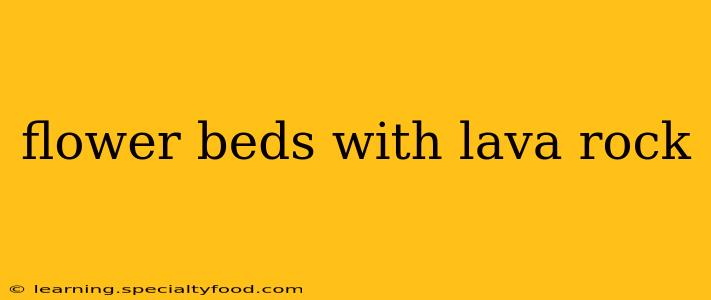Lava rock, with its rugged texture and rich, dark hues, adds a unique and dramatic element to any garden. Its porous nature also offers excellent drainage, making it an ideal material for flower beds, particularly those prone to waterlogging. This guide explores the many benefits of using lava rock in your flower beds, offering tips and inspiration for creating stunning and low-maintenance landscapes.
Why Choose Lava Rock for Flower Beds?
Lava rock offers a multitude of advantages for landscaping, making it a popular choice for flower beds:
- Exceptional Drainage: Its porous structure allows for excellent water drainage, preventing waterlogged soil that can harm plant roots. This is especially beneficial in areas with heavy rainfall or clay soil.
- Weed Suppression: The rock's surface acts as a natural barrier, significantly reducing weed growth compared to mulch or bare soil. This translates to less weeding and more time enjoying your garden.
- Temperature Regulation: Lava rock retains heat during the day and releases it slowly at night, helping to regulate soil temperature and protect plant roots from extreme fluctuations.
- Aesthetic Appeal: Its dark, volcanic texture provides a striking contrast to the vibrant colors of flowers, creating a visually appealing landscape. The rough, natural look complements various garden styles, from modern minimalist to rustic cottage.
- Low Maintenance: Beyond the initial installation, lava rock requires minimal maintenance. It doesn't decompose or need replacing like organic mulches.
What Types of Lava Rock are Best for Flower Beds?
Several types of lava rock are suitable for flower beds. The most common include:
- Lava Rock Mulch: This is a finely crushed variety, ideal for covering larger areas and providing a uniform look. It comes in various sizes, allowing for customization based on your needs.
- Lava Rock Gravel: Larger pieces of lava rock offer a more dramatic and textured look. It's particularly effective in creating pathways or edging around flower beds.
- Lava Rock Boulders: Larger boulders can be strategically placed to create focal points or to define different sections within a garden.
Choosing the right size depends on the overall design and scale of your flower bed.
How to Create a Flower Bed with Lava Rock
Creating a stunning flower bed using lava rock involves a few simple steps:
- Preparation: Clear the area of existing vegetation, weeds, and debris. Loosen the soil to a depth suitable for your chosen plants.
- Weed Barrier (Optional): For optimal weed suppression, consider using a landscape fabric under the lava rock. This helps prevent weeds from sprouting through the rock.
- Soil Amendment: Improve your soil's drainage and fertility by adding organic matter like compost.
- Planting: Plant your chosen flowers, ensuring proper spacing according to their mature size.
- Lava Rock Application: Spread the lava rock evenly over the soil, covering the surface completely. The depth of the lava rock layer can vary depending on your preference and the size of the rock. A layer of 2-4 inches is generally sufficient.
What Plants Thrive with Lava Rock?
Many plants thrive in well-drained soil provided by lava rock. Consider plants that tolerate dry conditions and full sun:
- Succulents: These are ideal for lava rock beds due to their drought tolerance.
- Cacti: Similar to succulents, cacti are well-suited to the dry conditions provided by lava rock.
- Lavender: This fragrant herb thrives in well-drained soil and full sun.
- Sedum: These hardy plants offer a variety of colors and textures.
- Rosemary: Another drought-tolerant herb that adds fragrance and beauty.
Is Lava Rock Expensive?
The cost of lava rock varies depending on the type, quantity, and location. Generally, it's a relatively affordable landscaping material compared to other options like gravel or decorative stones. Bulk purchases often result in cost savings.
Does Lava Rock Affect Soil pH?
Lava rock itself doesn't significantly affect soil pH. However, the type of soil you use in conjunction with the lava rock will determine the overall pH of the planting area.
How Often Should I Water Plants in a Lava Rock Flower Bed?
Watering frequency depends on the climate, plant type, and the size of the lava rock used. Generally, plants in lava rock beds require less frequent but deeper watering to encourage strong root development. Check the soil moisture regularly, adjusting watering as needed.
By incorporating lava rock into your flower beds, you can create a stunning landscape that's both visually appealing and low-maintenance. The unique texture and excellent drainage properties of lava rock make it a valuable asset to any gardener seeking a striking and practical solution for their flower beds.
